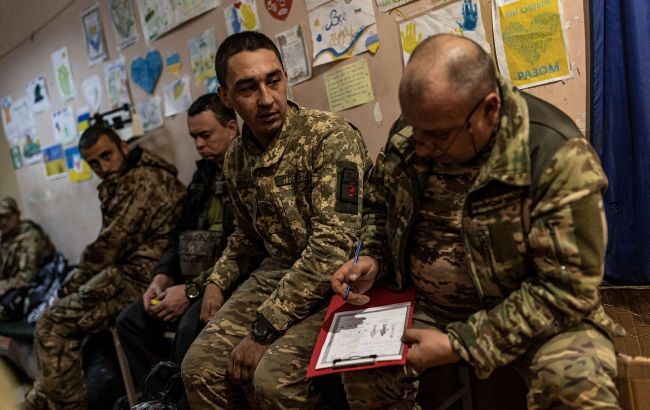Draft lottery: U.S. experience and reasons for Ukraine's current debate
 Ukrainians actively discuss the idea of mobilization through a lottery (Photo: Getty Images)
Ukrainians actively discuss the idea of mobilization through a lottery (Photo: Getty Images)
Amid the preparation for a law on mobilization reinforcement and a new conscription procedure on social media, another idea is being discussed. It involves the possibility of determining conscription through a lottery system.
RBC-Ukraine details how the United States implemented such a practice and why it's being talked about in Ukraine.
The material was prepared using information from Tymofii Mylovanov's Facebook page, sources from BBC News Ukraine and Forbes, data from Wikipedia, and posts from the Selective Service System website (the U.S. government agency responsible for maintaining draft records).
Mobilization through lottery: Fairness at the expense of efficiency?
The discussion about a fair format of mobilization started after criticism of the idea of conscripting those who earn high salaries and pay substantial taxes that contribute to the military upkeep.
Former Minister of Economics, President of the Kyiv School of Economics, and member of the supervisory board of Ukroboronprom (manufacturer of weapons), Timofii Milovanov, has noted on his Facebook page that discrimination still exists, as affluent individuals with connections often evade conscription due to corrupt practices.
He was the first to publicly propose the idea of mobilization through a lottery as a potential compromise. Although actively discussed among social media users, this model isn't under consideration by the government.
In late December, Milovanov posted about the conflict between fairness and effectiveness in mobilization. He studied other countries' experiences during wars and highlighted the approach used in the United States, where several lotteries were conducted during the 20th century.
"Publicly, birthdates were transparently drawn. Everyone born on that day at a specific age was conscripted. It was this way during world wars. During Vietnam, the mechanism was more complex, but still, conscripts were chosen randomly and fairly. The lottery was considered a fair mechanism because everyone was equal," wrote Milovanov.
However, this mechanism was deemed ineffective since it could conscript key scientists or engineers, causing more harm than benefit in their mobilization. Thus, a simple and clear conscription mechanism was necessary.
For instance, during World War I, one could buy out of conscription by paying $300 (equivalent to $10,000 today), or find someone to serve instead. Yet, such a mechanism might not function in Ukrainian realities.
"Society would perceive it as unfair. Although there are many corrupt schemes where people buy their way out of mobilization - as often happens in practice, it's illegal," he noted.
This story highlights the conflict between fairness and efficiency. Efficiency demands the conscription of those vital to the economy, though their importance is hard to measure. Fairness dictates that everyone has an equal chance of conscription under uniform rules, from the unemployed to key figures in the economy and defense industry.
Milovanov emphasizes that there's no right solution; it's a political matter that needs addressing based on the mood in Ukraine. Pleasing everyone is impossible, and sacrifices will be made, either for fairness, efficiency, or both.
Recently, he posted the following on Facebook: "Most of my readers write that the right approach to mobilization is through a lottery or drawing lots. The state randomly picks a day and month. Those born on these days get conscripted, others don't. And it's done for each wave of mobilization. I don't think it's the right approach. But... What do you think?"
The expected response from Facebook users was predominantly critical. Most don't believe that even with a lottery, all Ukrainians would be on equal footing.
The American experience: How it worked from world wars to Vietnam
The lottery system for military recruitment was first introduced in 1863 during the American Civil War. Certain groups, such as African American citizens and immigrants, were exempted from conscription. Those selected in the lottery could officially buy their way out of service for $300 or find a substitute. Although these norms were abolished in 1917, the lottery system persisted.
During World War I, the United States conducted three such lotteries, adding almost 2.7 million individuals to the military out of 24 million eligible conscripts. Each man registered in his county and received a sequential number. The lottery involved 10,500 numbers, with many individuals registered under one number. The drawing took place at the Department of Defense building in Washington, where a designated official picked out numbers for conscription. Those with the corresponding number were called for service, while the rest remained civilians until the next lottery.
A similar lottery was conducted during World War II. The process heightened the randomness effect by shuffling conscript cards twice and having a blindfolded individual draw the lottery balls. Four lotteries were held, but after 1942, the US switched to mass conscription. During the war years, the country mobilized over 10 million individuals.
Criticism arose against the lottery mechanism, leading to the Vietnam War mobilization in 1965 without it. By the end of 1966, there were about 385,000 American soldiers deployed, reaching nearly half a million more in just a year. Key decisions regarding conscription were delegated to local draft boards. Men were registered, and if they didn't have exemptions, they could likely be sent to war according to the quota. It was believed that the quota affected poor citizens and those unable to influence the draft board's decision. This resulted in widespread protests led by figures like Muhammad Ali and Martin Luther King. The largest demonstration occurred on November 15, 1969, when around 500,000 people marched on the White House. As a result, the authorities reinstated the lottery.
The first Vietnam War-era lottery was held live on December 1, 1969. Approximately 850,000 Americans born between 1945 and 1950 participated. There were 366 capsules containing birth dates (including February 29), representing the sequence number for men aged 19 to 25. The first drawn capsule held the number 258, corresponding to the date September 14. Therefore, all men born on September 14 between 1944 and 1950 were assigned the first sequential number. The lottery continued until all days of the year were matched with numbers.
For the 1970 draft, the US Department of Defense set the lottery number ceiling at 195. This meant that those with lower sequence numbers could be called for service accordingly. Among those born on the same day, the order was determined by initials. For instance, individuals with initials starting with "JJJ," "JGJ," "JDJ," and so on were called first, while those starting with "VVV" were last.
After 1970, the lottery was held six more times until 1975, involving only 19-year-old men. The last draft through the lottery occurred in 1972, conscripting a total of 2.2 million Americans during the Vietnam War.
Since 1973, the US Armed Forces have recruited on a contractual basis. However, a continuous military registration for men aged 18 to 25 (US citizens and green card holders) is maintained in case of reactivation of the draft. Registration is mandatory, and failure to comply can result in fines up to $250,000 or denial of various privileges. Non-citizen migrants may be denied citizenship if they fail to register.
As of today, the lottery is not conducted in the US due to its redundancy. Yet, in some countries, active military enlistment is determined by a draw. In Denmark, conscripts pull a ticket, deciding whether they go home or serve in the military for 4 to 12 months. Another option in Thailand involves card selection. If one draws a red card, they serve in the army for two years; if black, they are exempted from service. These lotteries are conducted publicly and often turn into a kind of show.
Reservation for the wealthy? What else can change in Ukraine
Since the start of the Russian invasion, Ukraine has received tens of billions of dollars in budgetary aid from its partners. However, in accordance with donor requirements, these funds cannot be allocated to the military but only for social and humanitarian needs. Financing for the Armed Forces and other defense services is managed through internal loans and taxes.
During the year-end press conference for 2023, President Volodymyr Zelenskyy announced that the military command had requested the mobilization of 450-500 thousand individuals.
"This is a very serious number. I have stated that I need more arguments to support this direction because it concerns people, fairness, defense capabilities, and finances," he noted.
Mobilizing such a number of people comes with a cost. According to Zelenskyy, it would require an additional 500 billion hryvnias. Yet, there's no clear answer to where these funds might be sourced from.
The new bill aims to intensify the campaign. The key provisions include lowering the minimum age from 27 to 25 years, involving the police and local authorities in mobilization, and strengthening accountability for draft evasion and violations of military registration rules. This week, the relevant committee has begun its review.
Certain norms within the draft have sparked strong reactions within society, and sources from RBC-Ukraine in the Parliament indicated that the current version of the document might not be voted on before the new year. It may either be revised or a different project will be introduced.
Theoretically, this means that changes related to exemptions could be introduced in the mobilization law. As Forbes reports, the President's Office has already proposed some ideas. Specifically, an additional criterion for exemptions could be the amount of taxes paid from official salary or income.
According to Forbes's data, the proposed options are:
Exemption for individuals paying no less than 6,000 hryvnias of personal income tax per month. For this, the official salary should be around 33,500 hryvnias (twice the average salary in Ukraine). An additional 22% should be paid by the employer in the form of a single social security tax.
Exemption for those for whom the employer pays a single social security tax of approximately 14,500 hryvnias (corresponding to an official salary of about 66,000 hryvnias).
According to Forbes, representatives of the IT sector, with specific tax criteria for exemptions, should earn no less than 3,200 dollars. Similar rules might be extended to entrepreneurs in a simplified tax system, but a ready-made scheme for them isn’t available yet. It's anticipated that after updating tax payment information, a QR code will be generated in the Oberih database of conscripts, ensuring exemption for 45 days.
It's worth noting that the authorities haven't officially commented on this information. However, Ukrainians are concerned that such an approach might shield the wealthy from mobilization while the burden of war would fall more heavily on the less affluent.

